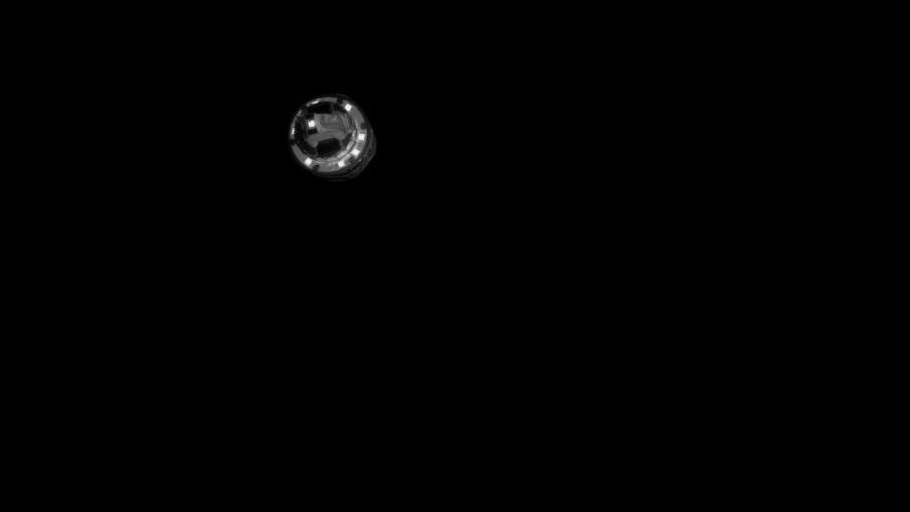Japan's Hayabusa2 Shoots Copper Bomb at Asteroid Ryugu to Create Artificial Crater
It may take some time to determine how the operation went.

Update: JAXA officials announced this morning (April 5) that the impactor did indeed hit Ryugu. Mission team members are now working to confirm that a detectable crater was generated.
A Japanese spacecraft deployed a heavy, explosive-packed copper plate toward the asteroid Ryugu in an attempt to create an artificial crater last night (April 4), but it's still unclear how the dramatic operation went.
The Hayabusa2 spacecraft, which has been studying the 3,000-foot-wide (900 meters) Ryugu up close since last June, released a 4.4-lb. (2 kilograms) hunk of copper late last night, along with a camera known as DCAM3 to record this "Small Carry-on Impactor" (SCI) operation.
"The spacecraft state is normal and it was confirmed that the evacuation operation, the separation of the SCI and DCAM3 went as planned. The SCI separation and evacuation sequence were a success," mission team members wrote on Twitter around 2 a.m. EDT (0600 GMT and 3 p.m. Japan time) today (April 5).
Related: Photos: Japan's Hayabusa2 Asteroid Sample-Return Mission
An onboard explosive charge was scheduled to detonate last night at 10:36 p.m. EDT (0236 GMT and 11:36 a.m. Japan time this morning), sending the plate hurtling toward Ryugu's boulder-strewn surface at about 4,500 mph (7,240 km/h).
But the detonation, and the resulting impact, had not yet been confirmed as of the time of this writing.
Get the Space.com Newsletter
Breaking space news, the latest updates on rocket launches, skywatching events and more!
[SCI] April 5 at 13:45 JST: Gate 5 was confirmed. The spacecraft state is normal and it was confirmed that the evacuation operation, the separation of the SCI and DCAM3 went as planned. The SCI separation and evacuation sequence were a success.April 5, 2019
This procedure wasn't for entertainment — instead, it will help scientists understand Ryugu's interior.
During the carefully choreographed procedure, the Hayabusa2 mothership retreated behind the asteroid, for safety. (That's the "evacuation" the mission team mentioned in the above tweet.)
The main drama played out over the course of about 40 minutes, from the impactor's deployment to the (presumed) impact itself. But, provided it was successful, the operation will occupy scientists for much longer as they pore over images captured during the procedure. The researchers hope that by watching how debris flies away from the crater, they'll be able to better understand what Ryugu is made of.
Over the next two weeks or so, the main Hayabusa2 spacecraft will slowly creep out of hiding and return to its "home position" about 12.4 miles (20 kilometers) above Ryugu's surface.
If all goes well, Hayabusa2 will take a closer look at the crater itself to study the interior of the asteroid, where radiation hasn't affected the rock. The team running the mission even hopes they'll be able to grab a sample of material from this location, to add to the surface sample the probe collected in February.
Indeed, Hayabusa2 has been extremely busy during its time at Ryugu. In addition to the sample-collection and SCI activities, the probe has studied the asteroid in detail and released two hopping minirovers and a 22-lb. (10 kg) lander onto the space rock's surface.
And Hayabusa2 still has one more tool to deploy: MINERVA-II 2, a third, tiny, hopping rover, similar to those the probe deployed in September. The mission team currently hopes to send MINERVA-II 2 out onto Ryugu's surface late this summer.
After that task is complete, all that's left for Hayabusa2 to do is head back to Earth, carrying with it precious souvenirs of the space rock it will have spent a year and a half studying.
That sample is scheduled to come down under parachute in December 2020, in a special return capsule.
- Diamond Asteroids: How Bennu and Ryugu Got Their Fancy Shapes
- Hop, Don't Roll: How the Tiny Japanese Rovers on Asteroid Ryugu Move
- Japanese Spacecraft Successfully Snags Sample of Asteroid Ryugu
Email Meghan Bartels at mbartels@space.com or follow her @meghanbartels. Follow us on Twitter @Spacedotcom and on Facebook.
Join our Space Forums to keep talking space on the latest missions, night sky and more! And if you have a news tip, correction or comment, let us know at: community@space.com.

Meghan is a senior writer at Space.com and has more than five years' experience as a science journalist based in New York City. She joined Space.com in July 2018, with previous writing published in outlets including Newsweek and Audubon. Meghan earned an MA in science journalism from New York University and a BA in classics from Georgetown University, and in her free time she enjoys reading and visiting museums. Follow her on Twitter at @meghanbartels.









